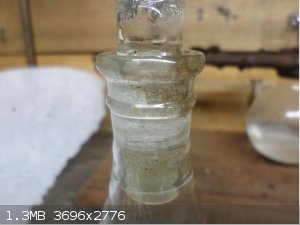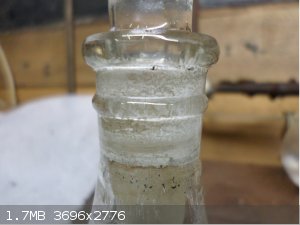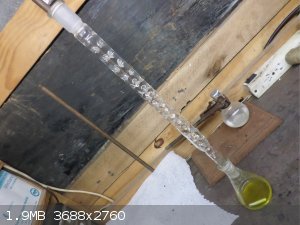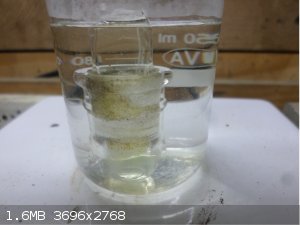Chem Science
Hazard to Others
  
Posts: 122
Registered: 30-7-2018
Location: Argentina
Member Is Offline
|
|
Dioxanes ? YOU MUST KNOW THESE INFO
THESE IS A WARNING FOR DIOXANES SYNTHESIS
Hi everyone !
So i was working on the synthesis of Dimethyl Dioxane from Propylene Glycol and Phosphoric acid, and have a very unpleasant result. In one of the
purification steps it is recommended to react the dioxane with Sodium Hydroxide solid, and then distill the product, here is the RISK .. Dioxane and
dimethyl dioxane can dissolve sodium hydroxide and during distillation some product splashes to the ground glass joint and leaves Sodium Hydroxide ..
and yes you know what these means.. it welds the joint and you can say goodbye.i think using grease or PTFE in these cases is the best way to protect
your glassware, honestly i will make sure to do these from here on. For me these means some months until i can replenish glassware especially ground
glass glassware. The last picture you see is the bottom of the fractionation column in warm dilute HCl solution .. tomorrow i will tell you if i could
get my column back ... Fingers crossed
I will also, in a couple of weeks after i finish my experiments, publish my results with yields and how phosphoric acid works. But i felt like these
needed to be known known
   
[Edited on 24-6-2019 by Chem Science]
|
|
|
XeonTheMGPony
International Hazard
    
Posts: 1636
Registered: 5-1-2016
Member Is Offline
Mood: No Mood
|
|
warm joint, add slightly acidic water, allow to cool, rinse and repeat till free, or soak, start with hot water then allow to cool while submerged.
Naturally befor you try yarding it off!
[Edited on 24-6-2019 by XeonTheMGPony]
|
|
|
Chem Science
Hazard to Others
  
Posts: 122
Registered: 30-7-2018
Location: Argentina
Member Is Offline
|
|
I did warm it,low heat and hi heat, add acid yes, add oil, let it cool in between attempts ... all fail .. If it separates after the overnight warm
acid bath .. then i know i FU*** SHOULD HAVE DONE THAT FIRST   ... ...  Love that
flask ... So F**** (-_-) ... but well sometimes you just gotta let go Love that
flask ... So F**** (-_-) ... but well sometimes you just gotta let go 
|
|
|
Sulaiman
International Hazard
    
Posts: 3555
Registered: 8-2-2015
Location: 3rd rock from the sun
Member Is Offline
|
|
If you are unable to separate the flask and column, then I'd
use a blowtorch or similar to rapidly heat the outer joint whilst tapping and wriggling the joint ... if I had a blowtorch.
or
hold the column in your (gloved) hand,
start tapping around the flask at the top of the joint with a metal rod/bar,
as multiple sharp taps can often loosen a frozen joint,
keep increasing the strength of the taps until either the flask and column separate,
or the flask neck breaks and hoefully you can keep the column.
This is a last resort action as you could loose both the flask and column.
or, probably better,
consider the column and flask as a single unit, use it as it is.
I doubt that the NaOH in the joint will significantly contaminate refluxing or distillations,
and maybe with repeated use the joint may free itself ?
------------------------------
For a simple siezed joint I applied WD40 silicone lubricant, waited one day, then tap-tap-wiggle-wiggle.
CAUTION : Hobby Chemist, not Professional or even Amateur
|
|
|
Keras
National Hazard
   
Posts: 766
Registered: 20-8-2018
Location: (48, 2)
Member Is Offline
|
|
Attached is the 1,4-Dioxane purification process as suggested in the book Purification of Laboratory Chemicals, it doesn’t mention NaOH,
but Na metal.
Attachment: Dioxane.pdf (193kB)
This file has been downloaded 230 times
[Edited on 24-6-2019 by Keras]
|
|
|
Ubya
International Hazard
    
Posts: 1232
Registered: 23-11-2017
Location: Rome-Italy
Member Is Offline
Mood: I'm a maddo scientisto!!!
|
|
the title is a bit clickbaity, the problem is not really about dioxanes, it's about a stuck ground glass joint.
@sulaiman using heat and tapping would work for a normal stuck joint (just friction), but in this case sodium hydroxide attacked the glass, dissolving
part of it forming sodium silicate, a good high temperature binder.
letting the joint sit in a warm water bath for a prolonged period of time should dissolve any NaOH and sodium silicate, than is a matter of whatyou
said, gently tapping and heating to free the joint. warm acidic water should be better, but now that i'm thinking any sodium silicate formed will turn
into silicon dioxide (silica gel), trapped in the joint, i thounght it could be a problem, but using acidic water is the normal protocol for this
situation so probably i'm overthinking
---------------------------------------------------------------------
feel free to correct my grammar, or any mistakes i make
---------------------------------------------------------------------
|
|
|
Pumukli
National Hazard
   
Posts: 686
Registered: 2-3-2014
Location: EU
Member Is Offline
Mood: No Mood
|
|
I could successfully disconnect stuck joints with the help of a heat gun - similar method as Sulaiman suggested, though somewhat less drastic. It
required some beating around/ knocking the joint on the edge of a WOOD table though.
(In my case the joint was stuck because a little NaOH got there when I tried to dry pyrrolidine on NaOH in the flask.)
|
|
|
Chem Science
Hazard to Others
  
Posts: 122
Registered: 30-7-2018
Location: Argentina
Member Is Offline
|
|
No it's literally weld together, overnight in an acid bath and it's dry in between the joints.These is a sad day. I don't have sodium metal, cannot
yet make it (Hi temp. Hot-plate broken, still waiting the part i ordered).I Did try the fast heating method but with a nice bunsen burner and not a
blowtorch. But now i think a blowtoch wasn't going to help either.
I did debate of using both as it is but for my particular situation was not possible.
Sorry for the Tricky Title i just wanted everyone to know so they can take precautions.
Ill let you know if i did get them separated  Thanks for the suggestions Thanks for the suggestions
|
|
|
XeonTheMGPony
International Hazard
    
Posts: 1636
Registered: 5-1-2016
Member Is Offline
Mood: No Mood
|
|
Do you have a dremmel? under flowing cold water with the diamond bit cut it off to recover the column
|
|
|
Keras
National Hazard
   
Posts: 766
Registered: 20-8-2018
Location: (48, 2)
Member Is Offline
|
|
Unfortunately, this is a good remainder that distilling a product over NaOH should really be avoided.
Were you using NaOH to get a dry product? Maybe calcium chloride or magnesium sulfate would have been enough?
|
|
|
Chem Science
Hazard to Others
  
Posts: 122
Registered: 30-7-2018
Location: Argentina
Member Is Offline
|
|
My intention was to ger rid of the aldehydes in the prep of the dimethyl dioxane. Unfortunately .. test with basic KMnO4 suggest presence of something
.. hydrolysis of dimethyl dioxane ? mm .. By-Products ? probably  I fail in
EVERYTHING I fail in
EVERYTHING  
|
|
|
Keras
National Hazard
   
Posts: 766
Registered: 20-8-2018
Location: (48, 2)
Member Is Offline
|
|
Come on. I know it’s a pretty bad blow to lose a column, but it’s still better than the whole glassware blowing up in your face (so to speak). You
lose money, but you’re fine.
And also, as the signature of someone else mentions, “He who has never made a mistake has made nothing new.”
So, take heart and learn from it! I’m sure very honourable chemists have made bigger mistakes in the past.
|
|
|
Chem Science
Hazard to Others
  
Posts: 122
Registered: 30-7-2018
Location: Argentina
Member Is Offline
|
|
Well you are Right  I did lear something, and yeah my comments are exaggerated
hehe, Having replies is nice =) I will move on I did lear something, and yeah my comments are exaggerated
hehe, Having replies is nice =) I will move on  !! !!
|
|
|
happyfooddance
National Hazard
   
Posts: 530
Registered: 9-11-2017
Location: Los Angeles, Ca.
Member Is Offline
Mood: No Mood
|
|
Glasses (esp. silicates) are a funny material. Have fun and good luck getting that loose, and maybe wear some gloves!
|
|
|
Keras
National Hazard
   
Posts: 766
Registered: 20-8-2018
Location: (48, 2)
Member Is Offline
|
|
IMHO, the ground glass joint of the column must be badly eroded too. The column would be fine, but with a damaged joint, it is useless anyway.
|
|
|
fusso
International Hazard
    
Posts: 1922
Registered: 23-6-2017
Location: 4 ∥ universes ahead of you
Member Is Offline
|
|
Dioxane can dissolve NaOH? Maybe someone can use this to make Na using electrolysis...
|
|
|